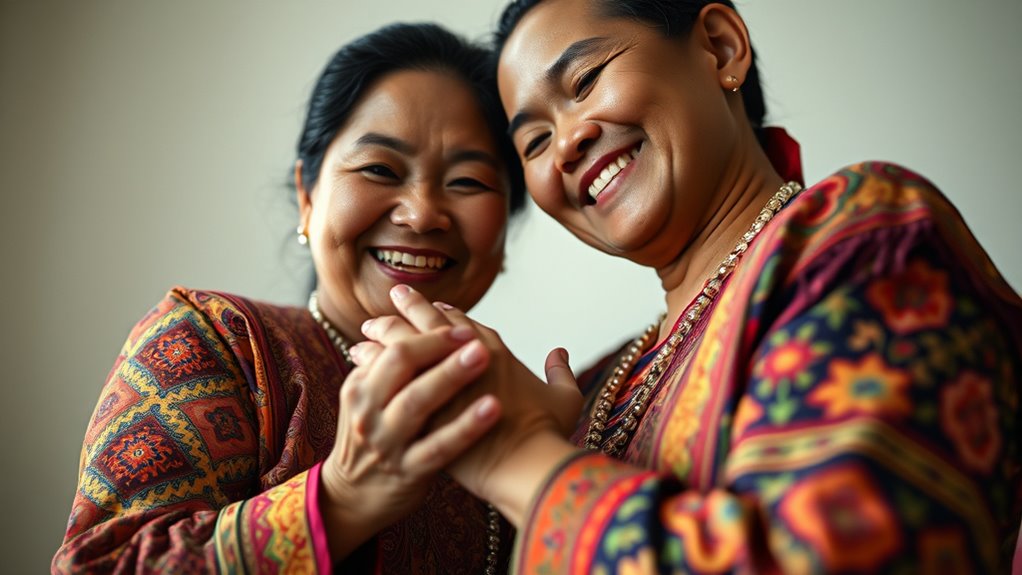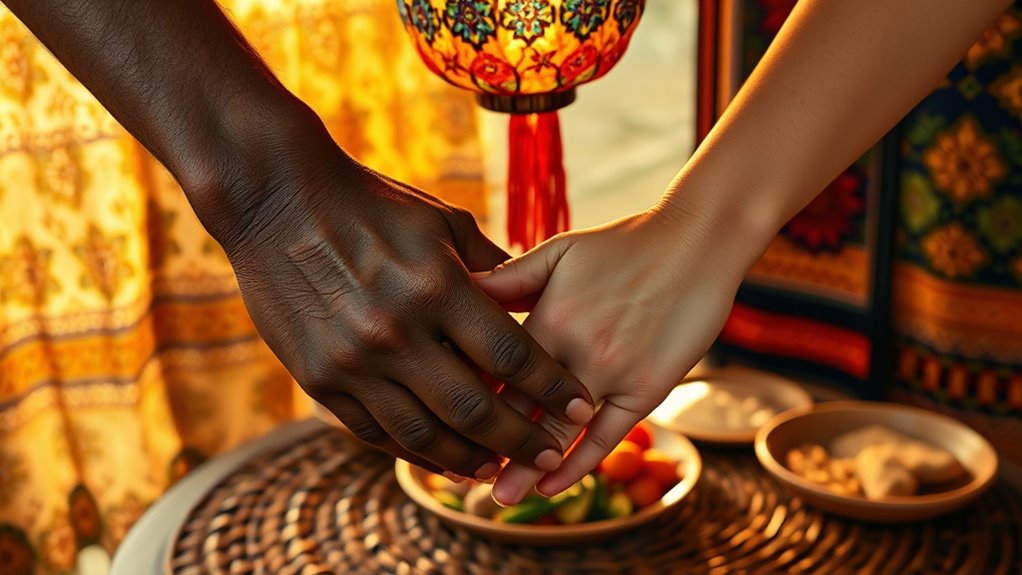The Filipino language adds depth to relationships by fostering respect and emotional connections. Politeness markers like “po” and “opo” show your consideration in conversations. Indirect communication helps convey feelings without confrontation, while non-verbal cues enhance understanding. Rich emotional vocabulary allows you to express complex feelings effectively. Hierarchical language acknowledges social structures, reinforcing respect. Together, these aspects create strong bonds among individuals in Filipino culture. Discover how these elements come together to enrich relationships even further.
Key Takeaways
- The use of polite markers like “po” and “opo” demonstrates respect, enhancing relational depth in Filipino communication.
- Indirect communication conveys deeper meanings, fostering understanding and preserving relationships while avoiding confrontations.
- Rich emotional vocabulary allows for precise articulation of feelings, deepening connections through effective emotional sharing.
- Non-verbal cues, such as gestures and body language, reinforce messages and express respect, enriching interpersonal dynamics.
- Hierarchical language reflects social structures and familial respect, promoting harmony and reinforcing bonds within relationships.
The Role of Politeness in Communication

Politeness is essential in Filipino communication, shaping how you interact with others. It plays a significant role in maintaining harmony and respect in your conversations.
Politeness is crucial in Filipino communication, fostering harmony and respect in every interaction.
When you use markers like “po” and “opo,” you demonstrate a deep understanding of respectful communication, especially in formal settings. This respectful vocabulary enhances your social interactions and fosters stronger relationships.
You’ll notice that polite expressions, such as “pasensya po,” go a long way in showing consideration. By balancing direct and indirect language, you can avoid conflicts and navigate social situations more effectively.
Whether you’re shopping or engaging in everyday conversations, polite phrases set a positive tone, reflecting the cultural values that emphasize harmony and respect in all interactions.
Understanding Indirect Communication

While direct communication may be straightforward, understanding indirect communication is essential in Filipino culture, where subtlety often reigns supreme. This style conveys messages that often go beyond literal meanings, helping to maintain social harmony and avoid conflict.
For instance, phrases like “Papunta na” can imply more than just being on the way, addressing deeper concerns about punctuality. By embracing indirect communication, you preserve relationships and prevent confrontations that could be seen as abrasive.
However, the complexity of this communication method can lead to misunderstandings if you don’t grasp the context. Recognizing the cultural significance of indirectness can enhance your interactions and deepen your connections with others in Filipino society.
The Importance of Non-Verbal Cues

Non-verbal cues play an essential role in Filipino communication, as they often express emotions and intentions more powerfully than words alone. In Filipino culture, gestures, facial expressions, and body language are crucial for conveying messages.
For instance, lip pointing directs attention without using hands, while specific hand gestures have culturally unique meanings. Understanding these cues helps you avoid misinterpretations and fosters harmonious relationships.
Politeness is also reflected in your posture and gaze; slight hesitations or lowered eyes indicate respect. By recognizing the significance of non-verbal communication, you enhance your cultural competency and build deeper connections with others.
Navigating Emotional Expression

Understanding emotional expression in the Filipino language is vital for effective communication and relationship-building. The rich emotional vocabulary allows you to articulate feelings with precision.
Terms like hinagpis convey deep sorrow, while poot represents intense anger. When you use pagdaramdam, you can express feelings of hurt or resentment clearly. Furthermore, phrases like takot na takot highlight intense fear, helping others understand your emotional state.
This nuanced vocabulary fosters deeper connections, enabling you to share complex emotions effectively. Words like maawain and mapagpatawad emphasize compassion and forgiveness, enhancing interpersonal bonds.
Language and Hierarchical Respect

Effective emotional expression sets the stage for exploring how language conveys hierarchical respect in Filipino culture.
In Tagalog, you’ll notice words like “po” and “ho” that reflect respect and social hierarchy. These particles signal your understanding of relationships, showing deference to elders and authority figures.
Terms like “Kuya” and “Ate” further illustrate the importance of familial respect. Depending on your familiarity with someone, the level of formality in your language can shift, adapting to social contexts.
The use of terms like “Kuya” and “Ate” highlights the significance of familial respect in Filipino culture.
This respectful language not only reinforces cultural values but also helps maintain harmony in interactions, ensuring that you navigate relationships with care.
Ultimately, Filipino language serves as an essential tool for expressing respect and acknowledging social structures.
Colloquial Expressions and Their Impact

Colloquial expressions in Filipino culture play an essential role in shaping relationships, as they often convey emotions and sentiments that formal language might overlook. Terms like mahal and sinta add warmth, while phrases such as ang ganda mo and ang bait mo express affection and admiration.
You can deepen your connection by using playful slang like syota, which makes conversations feel more intimate. In long-distance relationships, saying Mahal, ang hirap ng LDR**** can resonate with shared struggles.
Building Trust Through Language

Language can be a powerful tool for building trust in relationships. When you learn your partner’s native language, it shows respect and genuine interest in their culture, fostering deeper connections.
Non-verbal communication, like body language and facial expressions, plays an essential role too; being attentive to these cues enhances understanding and trust. Additionally, grasping language nuances helps you translate emotions accurately, minimizing misunderstandings.
Using polite terms like “po” and “opo” creates a respectful atmosphere, nurturing trust. Finally, aligning your communication style with cultural values, such as employing indirect communication, can strengthen your bond by avoiding confrontations.
Cultural Sensitivity in Relationships

When steering relationships, understanding cultural sensitivity can greatly enhance your connection with your partner.
In Filipino culture, communication often leans towards indirectness, aiming to maintain harmony and avoid conflict. You’ll want to use respectful language, incorporating polite suffixes like “po” and “opo” to show respect.
Pay attention to non-verbal cues, as posture and tone carry significant meaning. Family dynamics also play an important role; gaining family approval is essential for success.
Balancing traditional values with modern perspectives can foster understanding. Embrace cultural practices, and encourage open discussions about your backgrounds.
Frequently Asked Questions
How Does Language Shape Cultural Identity in Filipino Relationships?
Language shapes cultural identity in Filipino relationships by serving as a bridge between communities.
When you use regional dialects, you connect deeply with local traditions and values, fostering a sense of belonging. Your choice of language influences how others perceive you, reflecting your education and social status.
Embracing linguistic diversity enriches your interactions, allowing you to appreciate unique cultural narratives and strengthen bonds with family and friends, creating a vibrant, unified identity.
What Are Common Misunderstandings in Cross-Cultural Filipino Communication?
Steering through cross-cultural Filipino communication is like walking through a dense fog; clarity often eludes you.
You might find that Filipinos communicate indirectly, prioritizing politeness over bluntness, which can lead to misunderstandings. Ambiguity lurks in conversations, and body language becomes your compass.
How Can Foreigners Learn Filipino Colloquialisms Effectively?
To learn Filipino colloquialisms effectively, immerse yourself in Filipino media like shows, movies, and YouTube channels.
Engage with native speakers through conversations and language exchanges, and attend cultural events to grasp social nuances.
Use language learning apps and flashcards for vocabulary practice, and keep a slang journal for review.
Finally, participate in social media groups to ask questions and connect with others, enhancing your understanding and usage of colloquial expressions.
What Role Do Dialects Play in Relationship Dynamics?
Dialects are like the threads weaving the fabric of relationships, each unique yet interconnected. They shape how you communicate, express love, and resolve conflicts.
When you embrace a partner’s dialect, it shows respect and deepens your bond. You might find that shared dialects create an unspoken understanding, while differences can spark curiosity.
Steering through these nuances enhances your connection, making every conversation a dance of cultures, emotions, and shared experiences.
How Does Social Media Influence Filipino Language Use in Relationships?
Social media shapes Filipino language use in relationships by blending traditional and modern expressions.
You’ll notice how digital slang creates a sense of community, making communication quicker and more relatable. When you use terms like *Forda Ferson* or *Dasurv*, you connect with others on a cultural level, enhancing your social identity.
This dynamic environment encourages you to adapt your language, fostering deeper connections while traversing diverse linguistic landscapes.
Conclusion
In your journey of building relationships, you’ve likely noticed how the Filipino language weaves subtlety and warmth into every conversation. You might find yourself pausing, considering the layers of politeness and respect it demands. But what happens when you embrace those nuances? You gain access to deeper connections, where trust flourishes and emotions flow freely. So, as you navigate these rich linguistic landscapes, ask yourself—how can you use this beautiful language to elevate your bonds even further?









